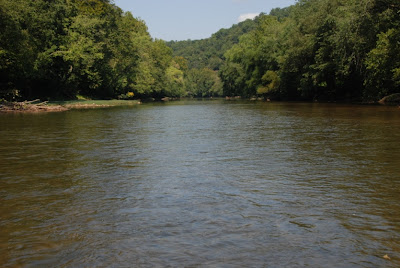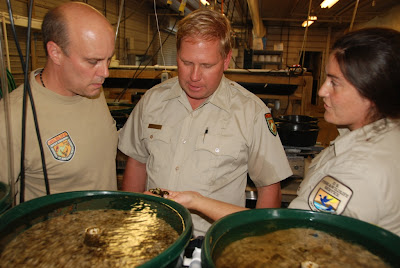It was a beautiful autumn morning, a perfect day to be out on the Elk River, my favorite river in the state, and doing something I love: restoring populations of endangered mussels.
| WATCH THE VIDEO |
The WCHS-TV crew tagged along the day these endangered mussels were released. Check out the Healthy Mussels Means Health Rivers eyewitness webcast. |
One of those endangered mussels, the northern riffleshell, hadn’t been seen here for almost 20 years. Fortunately, the Allegheny River in Pennsylvania still has a large northern riffleshell population, and our partners there were willing to allow us to transfer some of their mussels out of the path of a new highway bridge and into the Elk River, near an area where they historically occurred.
 |
| The Elk River, near where the endangered northern riffleshell mussels were re-introduced. Credit: Craig Stihler/WVDNR |
A lot of work had to be done before we could move the mussels to their new home. Existing mussel populations at the reintroduction site were monitored for a number of years to make sure that the area would be able to support the new group of northern riffleshell mussels. Then, after the mussels were gathered from Pennsylvania, the Service’s White Sulphur Springs National Fish Hatchery held the mussels at their facility for two weeks to make sure that the mussels were healthy and that no non-native species hitched a ride in the water used to transport the mussels from Pennsylvania to West Virginia.
Our partners with the West Virginia Division of Natural Resources went down to the hatchery and attached miniature PIT (passive integrated transponder) tags onto the shell of each mussel. These small tags are similar to microchips used in dogs and will allow us to monitor the success of the reintroduction.
 |
| West Virginia and U.S. Fish and Wildlife Service biologists check the mussels at the hatchery. Credit: Craig Stihler/WVDNR. |
We will use a special waterproof scanner to find the mussels – even when they are underwater or buried in the bottom of the river – and the PIT tags will emit an electronic signal that will identify the location and identity of each individual mussel. We hope to go back many years from now and find healthy reproducing populations of northern riffleshell living in the Elk River.
 |
| A PIT tag next to a northern riffleshell mussel. Credit: Craig Stihler/WVDNR |
So rivers with healthy and diverse mussel populations are usually also healthy and safe for other animals – and people too. Sometimes, by restoring one key group of wildlife in the river, we can help restore the entire ecosystem.
Read other posts that explore the importance and restoration of freshwater mussels in the Northeast.
Great to hear that local volunteer watershed groups are working to restore the river and improve fish habitat and recreational opportunities.
ReplyDelete